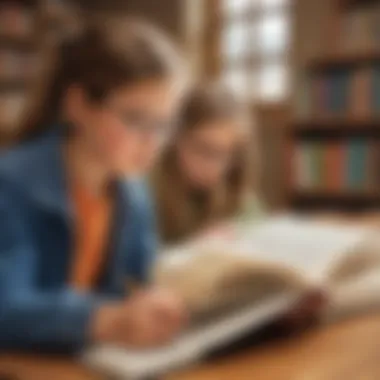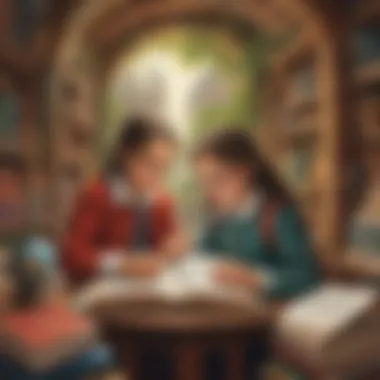Unlocking the Reading Potential: Strategies to Teach a 3rd Grader to Read


Creative Activities
In this section, we will explore a variety of creative activities designed to enhance a 3rd grader's reading skills. Craft ideas that stimulate imagination and fine motor skills will be shared, providing children with the opportunity to engage in hands-on learning. Step-by-step guides will accompany each activity, ensuring clarity and ease of replication. The educational value of these activities will be discussed, highlighting how they contribute to language development and critical thinking.
Fun Quizzes
Moving on to fun quizzes, we will list engaging topics covered in quizzes available on Elem Fun for 3rd graders. Explanation of question types used to spark children's interest and promote active participation will be provided. These quizzes serve as a tool for reinforcing knowledge acquired during reading sessions, helping solidify comprehension and retention.
Fact-Based Articles
Lastly, we will delve into fact-based articles covering a wide array of topics relevant to 3rd graders. These articles present information in an engaging and digestible manner, catering to young readers' learning preferences. Additionally, we will offer links to supplementary resources for further exploration and enrichment.
Introduction
Teaching a 3rd grader to read is a crucial aspect of their academic journey, laying the foundation for lifelong learning and intellectual development. In this article, we will explore effective strategies and techniques to enhance a child's reading abilities at this critical stage of their education. By delving into the importance of reading and providing an overview of the teaching process, we aim to equip educators and parents with valuable insights to create a nurturing reading environment for young learners.
Importance of Reading


Reading is more than just decoding words on a page; it is the gateway to knowledge, imagination, and cognitive growth. For a 3rd grader, developing proficient reading skills opens up a world of possibilities, enabling them to explore diverse ideas, cultures, and perspectives through literature. Moreover, reading fosters critical thinking, vocabulary expansion, and language fluency, preparing students to excel not only academically but also in various aspects of their lives. Therefore, emphasizing the significance of reading at a young age can significantly impact a child's overall cognitive development and academic success.
Overview of Teaching a 3rd Grader to Read
When approaching the task of teaching a 3rd grader to read, it is essential to adopt a structured and multifaceted approach that caters to individual learning styles and needs. This overview sets the stage for implementing effective instructional strategies that engage students and foster a love for reading. By understanding the components of successful reading instruction, educators and parents can create a supportive learning environment that enhances reading comprehension, fluency, and enjoyment. Through a carefully curated curriculum and thoughtful guidance, teaching a 3rd grader to read becomes a rewarding journey of discovery and growth.
Creating a Reading-Friendly Environment
A crucial aspect of teaching a 3rd grader to read effectively is the environment in which the learning process takes place. Creating a reading-friendly environment sets the foundation for a child's literacy development and enhances their overall reading experience. By focusing on specific elements such as setting up a cozy reading corner, providing access to diverse reading materials, and establishing a daily reading routine, educators and parents can significantly impact a child's reading journey. Each of these elements plays a vital role in nurturing a love for reading and maximizing the child's learning potential.
Setting Up a Cozy Reading Corner
Setting up a cozy reading corner offers a dedicated space where children can engage with books comfortably. This cozy spot should be inviting and conducive to focused reading. Including items like a soft rug, cushions, a well-lit reading lamp, and shelves stocked with age-appropriate books can transform a corner of a room into a captivating reading nook. A cozy reading corner provides a sense of sanctuary where children can escape into the world of stories and imagination, making the reading experience more enjoyable and immersive.
Providing Access to Diverse Reading Materials
Access to a wide range of reading materials is essential for nurturing a child's reading skills and interests. By offering diverse books that reflect different genres, cultures, and topics, educators and parents can cater to a child's varied preferences and expand their reading horizons. It is crucial to curate a collection that includes picture books, fiction, non-fiction, poetry, and other engaging formats to spark curiosity and encourage exploration. Diverse reading materials not only enhance vocabulary and comprehension skills but also foster a deeper appreciation for literature and a broader worldview.
Establishing a Daily Reading Routine


Consistency is key when developing a child's reading habits, making a daily reading routine a fundamental aspect of promoting literacy. Establishing a regular reading schedule helps to instill discipline and incorporates reading as a natural part of a child's daily routine. Whether it's setting aside specific times for reading, such as before bedtime or after school, or incorporating reading sessions into family activities, a structured routine reinforces the importance of reading in a child's life. Encouraging daily reading not only improves fluency and comprehension but also cultivates a lifelong love for learning and literacy.
Utilizing Phonics Instruction
In the realm of educating 3rd graders on the nuances of reading, the utilization of phonics instruction emerges as a fundamental pillar. Phonics serves as the gateway to decoding words and understanding the foundational elements of language. By delving into phonics, young learners embark on a journey of deciphering the connection between letters and sounds, paving the way for improved reading fluency and comprehension. Understanding how letter sounds correspond to written symbols allows children to navigate through texts with greater ease and confidence. Phonics instruction ignites a spark of curiosity within students, fostering a deeper appreciation for the intricacies of language and literature.
When exploring the domain of phonics instruction, special attention must be granted to the process of introducing letter sounds. This initial phase lays the groundwork for cultivating a solid foundation in phonemic awareness. By familiarizing students with the individual sounds of letters in the alphabet, educators equip them with the essential tools to begin constructing words and sentences. Through interactive and engaging activities, such as phonics songs and phonemic awareness games, children can actively participate in honing their auditory discrimination skills. The mastery of letter sounds serves as a springboard for young learners to dive into the realm of reading and unravel the mysteries contained within written texts.
Moving beyond the realm of individual letter sounds, the practice of blending and segmenting emerges as a pivotal aspect of phonics instruction. Blending involves the art of merging individual sounds to form coherent words, while segmenting requires students to dissect words into their constituent phonemes. By engaging in blending and segmenting exercises, 3rd graders enhance their phonemic awareness and phonics proficiency. Through hands-on activities like word blending puzzles and phoneme segmentation tasks, students hone their ability to manipulate sounds within words, thereby enhancing their decoding and encoding skills. The mastery of blending and segmenting empowers young readers to tackle more complex texts with confidence and comprehension.
As educators navigate the terrain of phonics instruction, one cannot overlook the significance of teaching phonics rules and patterns. By elucidating the rules governing phonics, such as digraphs, diphthongs, and consonant blends, teachers equip students with valuable tools to navigate through the intricacies of the English language. Introducing phonics patterns, such as vowel teams and silent consonants, further enriches students' understanding of how sounds interact within words. Through interactive lessons and visual aids, educators convey these complex phonics concepts in a digestible manner, enabling 3rd graders to apply these rules autonomously in their reading endeavors. Mastery of phonics rules and patterns empowers students to decode unfamiliar words with confidence and proficiency, propelling them towards a future filled with literary exploration and linguistic mastery.
Engaging Reading Activities
Engaging reading activities play a pivotal role in the holistic development of a third grader's reading skills. These activities stimulate a child's interest in reading, enhance comprehension abilities, and foster a love for literature at a young age. By incorporating engaging reading activities into educational practices, educators and parents can create a dynamic and enriching learning environment that nurtures a child's literacy journey. These activities not only make the learning process enjoyable but also facilitate cognitive development and language acquisition.
Word Games and Puzzles


Word games and puzzles offer an interactive and fun way to improve a child's vocabulary, spelling, and reading fluency. Through word games like crossword puzzles, word searches, and Scrabble, children can broaden their word bank, reinforce spelling patterns, and strengthen their cognitive skills. These activities enhance critical thinking and problem-solving abilities while encouraging active participation and engagement. By incorporating word games and puzzles into reading sessions, educators and parents can make learning entertaining and effective, promoting literacy development in an enjoyable manner.
Interactive Read-Aloud Sessions
Interactive read-aloud sessions are a valuable tool for developing a child's listening and comprehension skills. By engaging in interactive discussions during read-aloud sessions, children can deepen their understanding of stories, characters, and plot structures. This interactive approach encourages critical thinking, analysis, and interpretation of literary elements, fostering a deeper connection with reading material. Through guided questioning and reflective conversations, educators and parents can enhance a child's comprehension abilities and cultivate a supportive reading environment that promotes active engagement and mutual learning.
Creating Personalized Reading Journals
Creating personalized reading journals empowers children to reflect on their reading experiences, track their progress, and express their thoughts and emotions about the books they read. Personalized reading journals serve as a diary of a child's reading journey, documenting their favorite books, memorable passages, and personal reflections on literary works. By encouraging children to maintain reading journals, educators and parents can foster self-expression, creativity, and critical thinking, providing a platform for children to articulate their opinions and develop a deeper appreciation for literature. Reading journals also serve as a tool for self-assessment and goal-setting, promoting self-directed learning and reflective practices in young readers.
Encouraging Reading Comprehension
Encouraging reading comprehension is a vital aspect in the journey of teaching a 3rd grader to read. It plays a crucial role in enhancing the child's ability to understand and interpret written texts effectively. By focusing on this element, educators and parents can help children not only decode words but also comprehend the meaning behind them. Reading comprehension aids in improving critical thinking skills, vocabulary expansion, and overall cognitive development. Through thoughtful engagement with texts, young learners can grasp complex ideas, infer implications, and make connections between different pieces of information, thus fostering a deeper understanding of the content.
Asking Thoughtful Questions
In the process of encouraging reading comprehension, asking thoughtful questions is a key strategy. By prompting children to reflect on the material they have read, educators can gauge their understanding and encourage deeper analysis. Thoughtful questions challenge students to think critically, evaluate information, and draw conclusions based on the text. It also helps in developing their reasoning skills, enhancing their ability to articulate their thoughts clearly, and building confidence in expressing their interpretations. By posing questions that require reflection and analysis, educators stimulate intellectual curiosity and foster a habit of active engagement with reading materials.
Discussing Stories and Characters
Another essential component of promoting reading comprehension is discussing stories and characters with young readers. By engaging children in conversations about the plot, setting, and characters of a story, educators can deepen their understanding of narrative structures and character motivations. Discussing stories allows children to explore different perspectives, empathize with characters, and analyze the intricacies of storytelling. Through these discussions, children develop critical thinking skills, improve their ability to summarize and retell stories, and enhance their comprehension of complex narratives. Furthermore, delving into the emotional and psychological aspects of characters fosters empathy, promotes social awareness, and contributes to the overall cognitive and emotional development of young readers.
Connecting Texts to Real-Life Experiences
Finally, connecting texts to real-life experiences is a powerful strategy to enhance reading comprehension. By relating stories, articles, or poems to the child's own experiences, educators can make the content more relatable and meaningful. Drawing parallels between fictional events and real-life situations helps children make connections, draw comparisons, and understand the relevance of the text to their own lives. This practice strengthens comprehension by providing context, stimulating personal reflection, and encouraging active engagement with the material. Moreover, linking texts to real-life experiences promotes a deeper appreciation for literature, cultivates empathy, and nurtures a lifelong love for reading and learning.







